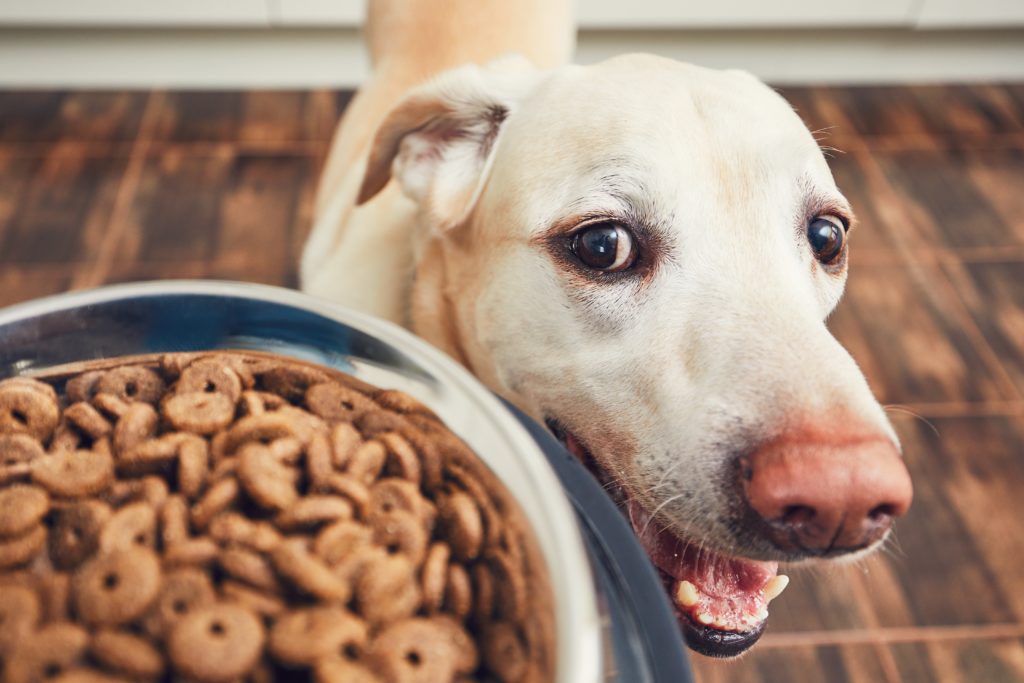
You see kibble. Your dog sees a bowl full of life-sustaining fuel and energy. In the wild, “resource guarding” is an essential skill: animals who can keep all paws off their food, mates, and territories have a better shot at survival. Making it in the Great Outdoors is one thing. Food bowl aggression inside your home is quite another – especially when kids are involved. What can you do if your dog displays resource guarding tendencies?
Food Guarding
Many dogs have a natural urge to protect their food. In the wild, they don’t know when they will get their next meal, and this reinforces the need to protect that which they do have. Our domestic pets still have traces of the wilderness left in them! Mild guarding is not usually cause for much concern. You may “treat” it by:
- Simply leaving your dog alone while he eats.
- Giving him enough food so he doesn’t feel to need to guard out of scarcity.
- Feeding your dog in another room, a crate, or behind a barrier (e.g. a baby gate).
When to Act
Food guarding becomes much riskier when children are involved. Small kids aren’t as adept at reading the dog’s cues. Say, for instance, that your child (or a visitor) approaches the food bowl while your dog is eating. His body may stiffen, and he keeps his head down to protect his food. If the kid doesn’t pick up on the signal, the aggressive behaviour may escalate to baring his teeth, growling, snapping, lunging, or even biting.
Some dogs do more than guard their own food bowls. They may guard food on tables and counters, as well as scraps that have fallen to the floor or food they’ve scavenged from trash cans. This can be dangerous to adults, as well as children. Their guarding may also extend to treats, toys, and even people.
If your dog’s guarding goes beyond “mild,” and he engages in threatening and aggressive behaviour, it is time to act. How can you keep everyone safe – and fed?
What To Do
Prevent Food Guarding
Ok, this won’t help much if you’ve got an older dog who already guards his food. But you can prevent the behaviour from taking root in puppies. When you bring a new dog home, feed him several meals from your hand. Give him one bite at a time, and speak soothingly to him. If he’s comfortable with that, transition to holding his bowl on your lap. As he eats from the bowl, pet him gently and speak to him calmly.
After several of these meals, put the bowl on the floor. As he eats, reach down a few times to add a treat (e.g. a piece of cheese or chicken) to his bowl. This will teach him that you’re a good provider and that he needn’t guard his food from you.
Treating Food Guarding Behaviour
So what happens if your dog already guards? First, assess his behaviour. Is he likely to bite you if you go near his food? If you fear this, please contact a qualified professional to help you. Animal behaviourists and veterinary behaviourists have specialized training so you don’t get hurt or further reinforce your dog’s tendencies.
Your dog’s not severely aggressive or likely to bite?
Do:
- Feed your dog at the same time each day. Some dogs guard because they don’t know when they’ll get to have another meal. Consistency helps relieve this anxiety.
- Walk your dog before he eats. This gives him the message that he’s earned his food. Also, train him to sit or lie down when you prepare his food. Make him stay after you put the bowl on the floor. Stand close to the bowl and then tell him to come.
- Are you thinking, “There’s no way my dog will sit until I tell him to come and eat!”? Enlist the help of a family member or friend. Leash your dog and have your assistant hold it. Prepare the food, put it on the floor, and then release the dog. This signals that you are in control. (You alpha dog, you!).
- Stand at a comfortable distance when your dog eats. Gradually reduce the distance between you and your pet (over several meal times). As you close the gap, toss a treat into his bowl.
- Give him a bowl full of nothing. He’ll wonder what’s up, but then he’ll start to want you to approach his food bowl (with food, of course).
- Drop a treat into his bowl every now and then. Again, this tells him it’s actually a good thing for you to be near his bowl.
- “Trade-Up.” When it’s chow time, approach your dog with his favourite treat. The goal is to have him stop eating his food and take the treat from you. This reassures him that you’re not going to steal his food and that it’s rewarding for him when you to come around his food bowl.
Don’t:
- Back away. When you back away from the bowl when your dog shows signs of food guarding, he wins. It reinforces the idea that he “won” and he gets the food as a reward.
- Act aggressively. The goal of treating food guarding is to desensitize him to anxiety and let him know you won’t take his food. Acting aggressively will raise his hackles – literally and figuratively. You don’t want to engage in a battle to be top dog. You are top dog when you act consistently and calmly.
- Feed him first. Again, alpha dogs eat first. Either feed your dog after the humans have eaten or at the same time.
Food guarding or aggression can be a serious problem. The biggest “don’t” is doing nothing. It can be relatively easy to reverse these behaviours with consistency, calmness, and as always, lots of treats and praise.


